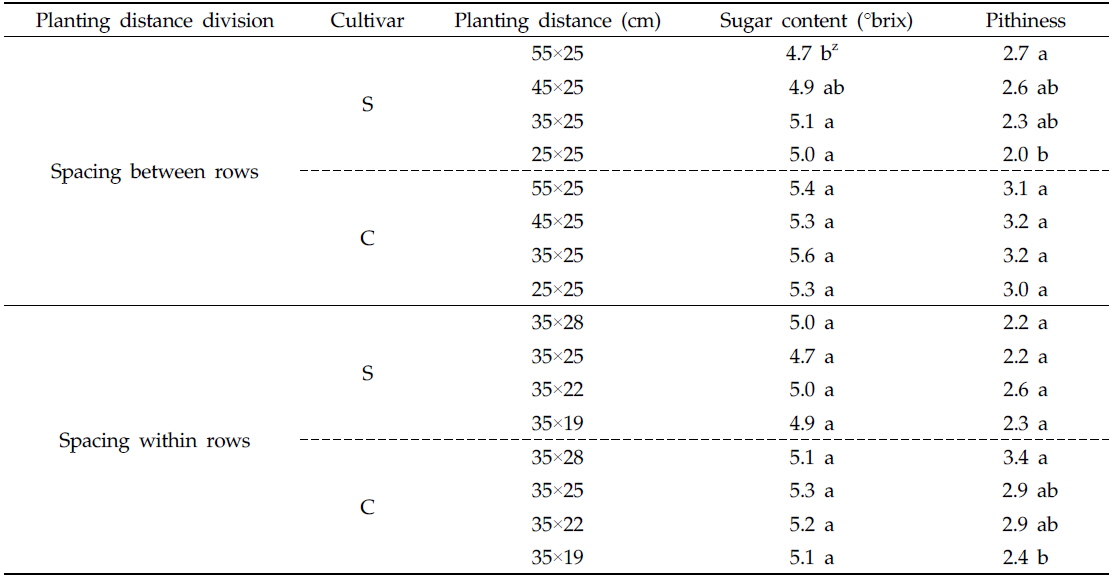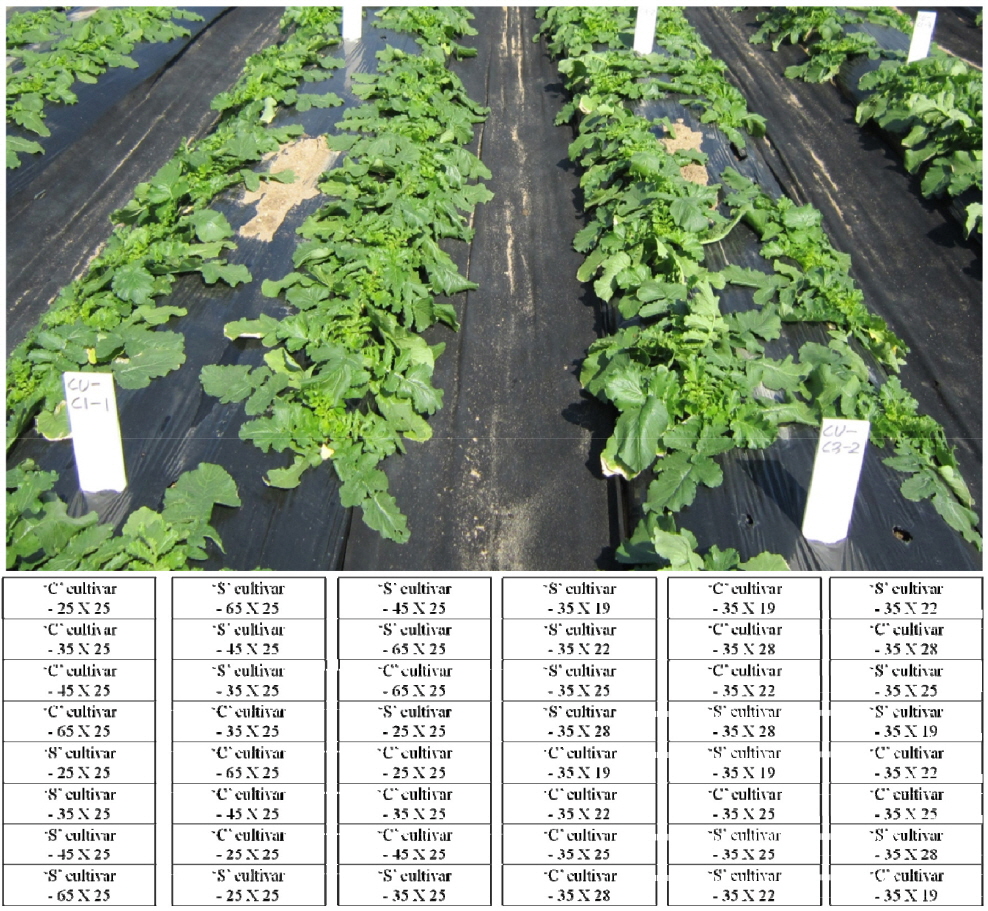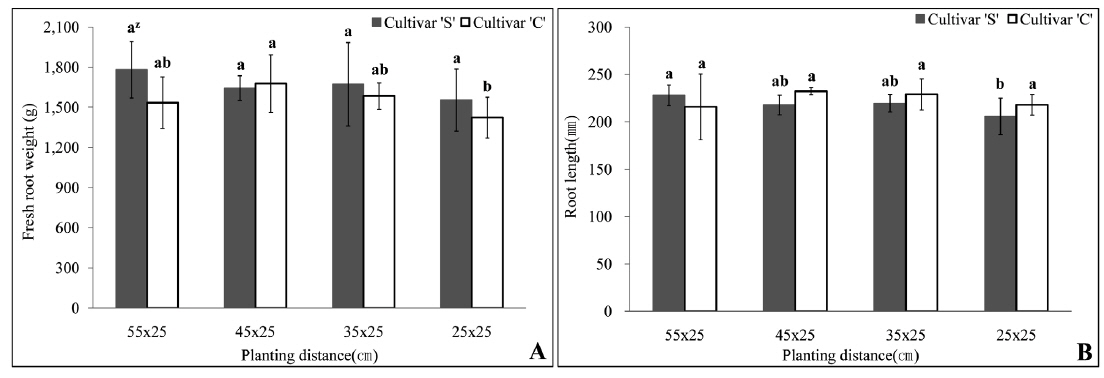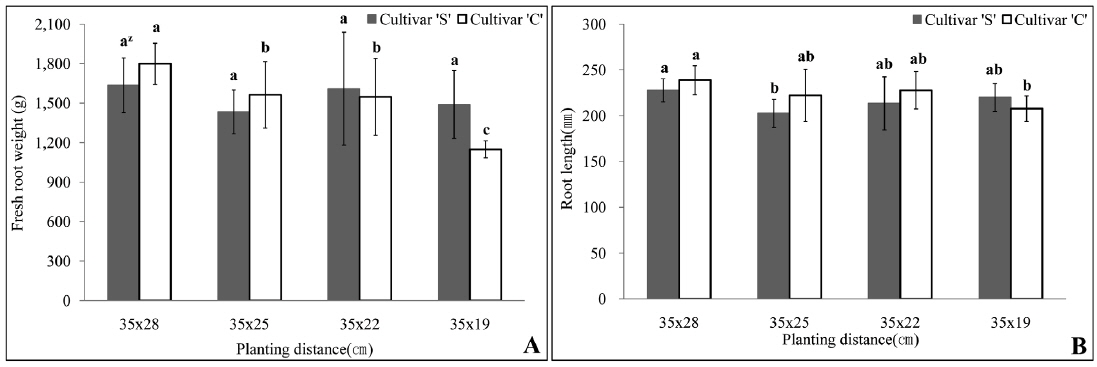



Radish (
Using top two popular autumn radish cultivars ‘S’ and ‘C’, seeds were sown in spacing between rows of 55×25, 45×25, 35×25 and 25×25 cm, and that within rows of 35×28, 35×25, 35×22 and 35×19 cm. Plants were harvested 58 days after sowing and leaf weight, length and number, and root weight, length sugar content and pithiness were investigated. In the spacing between rows, no significant difference was observed in leaf weight, length and number in both cultivars; however, 25 cm of spacing between rows significantly reduced the root length and weight in ‘S’ and ‘C’ cultivars, respectively. In spacing within rows, 28, 25 and 22 cm did not affect fresh root weight in both cultivars, producing appropriate radish roots of 1,500g on average. However, 19 cm of spacing within rows did not reduced fresh root weight in ‘S’ cultivar but did significantly in ‘C’ cultivar (1148.3 g). Sugar contents and pithiness of roots were also affected by spacing but its effect was very small and different between cultivars.
It is suggested that optimum double-row spacing in autumn radish cultivation is 35 cm and 22 cm of spacing between and within rows, respectively, the spacing that did not reduce the yield and quality of radish roots in two popular autumn radish cultivars.
무(
현재 무는 봄, 여름, 가을 및 월동재배를 통하여 연중 생산이 가능한데, 이는 1976년 발표된 만추대 품종인 ‘불암대형봄무’의 개발로 평지의 봄무 뿐만 아니라 고랭지의 여름무까지 재배가 가능해져 주년재배에 크게 기여했기 때문으로 판단된다(Lee, 1985; MOSF Report, 2013). 작형별 생산비중은 2000년 이후 봄무가 감소하고 월동무가 크게 증가하여 2013년 현재 봄무가 무 전체 면적의 34.4%, 여름무(고랭지무) 10.0%, 가을무 34.6% 및 월동무는 21.0%를 차지하고 있다(KREI Report, 2015).
노지 가을무 재배면적은 7,532 ha로 전체 재배면적 중 약 34.5%를 차지하고 생산량은 약 64만 톤으로 전체 생산량의 49.2%를 차지하는 무의 주요 작형이다(KREI Report, 2015). 가을무 재배의 경우, 강원도를 제외한 전국 대부분의 농가가 두 줄 재배를 실시하고 있으며, 두 줄 재배는 외줄 재배에 비해 대체로 단위 면적당 수량이 많고 관리가 편리하지만 작물을 밀식재배 하게 되므로 습해에 약한 경향이 있다. 대표농도경로 (Representative Concentration Pathways: RCP) 8.5를 적용할 경우 가을 강수량은 2030년까지 감소할 전망(KMA Report, 2012)이므로 향후 무를 가을재배 할 경우 두 줄 재배가 더 적절할 것으로 판단된다.
적정 재식거리를 설정하는 것은 한정된 면적에서 작물의 생육을 적절히 조절하면서 수확량을 최대로 하기 위해 꼭 필요한 연구이다. 현재 농촌진흥청 무 농업기술길잡이(구 영농 교본) 및 다른 무 재배지침서에서는 외줄 재배 표준 재식거리 60×25 cm를 기준으로 지역 및 품종에 따라 적절히 조정할 것을 권고하고 있다. 그리고 최근 무의 재식거리에 관한 국내 연구로는 기계화를 위한 재배양식 표준화(Oh
무 전체 생산량의 절반을 차지하는 가을재배에 주로 이용되는 두 줄 재배를 위한 표준 재식거리가 현재까지 설정되어 있지 않아 농민들이 경험에 따라 대략 열간거리 33~38 cm, 주간거리 22~25 cm 내외로 하여 무 종자를 파종하고 있는 실정이다. 따라서 본 연구는 가을무 재배 시 두 줄 재배의 적정 열간 및 주간 거리를 구명하기 위하여 실시하였다.
본 연구는 경기도 수원시 국립원예특작과학원 시험포장에서 수행하였다. 2013년 봄, 각 종묘회사 품종에 대한 시장조사를 통하여 가을무 품종 중 시장점유율이 가장 높은 시판 품종 S 및 C품종을 시험품종으로 본 실험에 이용하였다. 2013년 가을, 예비실험으로 두 시험품종을 다양한 열간 및 주간거리 조합을 작성하여 9월 3일에 파종하여 11월 12일에 수확한 후 생육 및 수확 후 특성을 조사하였다. 예비실험의 결과를 바탕으로 2014년 실험의 열간거리 처리의 범위를 25~55 cm, 주간거리의 범위를 19~28 cm로 설정하였다.
2013년 예비실험 결과, 열간거리가 60 cm 이상이면 무가 지나치게 두둑의 가장자리에서 자라 뿌리가 휘어진 무의 비율이 크게 높았고 열간거리 20 cm 이하와 주간거리 19 cm 이하에서는 무가 너무 밀식하여 정상적인 생육이 이루어지지 못했다(data not shown). 따라서 2014년 실험의 열간거리 처리의 범위를 25~55 cm, 주간거리의 범위를 19~28 cm로 설정하였다.
2014년 가을, 가을무의 적정 재식거리 구명을 위하여 S와 C품종을 2014년 8월 30일에 파종하였으며 파종 후 58일에 수확하였다. 적정 열간거리 구명을 위하여, 열간거리를 55×25, 45×25, 35×25 및 25×25 cm 등 4 수준으로 실험구를 작성하였다(Fig. 1). 모든 실험은 난괴법 3반복으로 수행하였으며 반복당 20립 씩 파종하였다. 이랑 간격은 120 cm로 설정하고 두둑과 고랑을 각각 70 cm, 50 cm 폭으로 설치하였다. 점적호스를 두둑 당 두 줄로 설치하였고 흑색 PE필름으로 멀칭하였으며, 고랑은 검은색 부직포를 덮어 시험포장을 조성하였다. 시험포장의 시비량은 무 농업기술길잡이(농촌진흥청)의 시비 기준인 완숙퇴비 1,000 kg, 질소(N): 인산(P): 칼리(K)을 10a 당 14:10:10 kg 기준으로 하여 질소와 칼리는 총 시비량의 60%, 인산은 전량 기비로 포장 전면에 고르게 시용하였으며, 50 cm 깊이로 3회 이상 경운하여 포장 내 토양 비옥도를 균일하게 하였다. 추비는 점적호스를 이용하여 2회에 나누어 관비하였으며 병충해 및 기타 재배관리는 무 농업기술 길잡이에 따라 실시하였다.
또한, 적정 주간거리 구명을 위해서 2014년 가을, 실험구를 35×28, 35×25, 35×22 및 35×19 cm 등 4 수준으로 작성하였다. 실험은 열간거리 구명과 마찬가지로 난괴법 3반복으로 수행하였으며 반복당 20립 씩 파종하였다. 또한 시험포장의 시비량과 이랑 및 고랑 조성은 열간거리 구명을 위한 실험과 같은 방법으로 실시하였으며 기타 재배관리 또한, 무 농업기술길잡이에 따라 실시하였다.
모든 무 식물체는 파종 후 58일(10월 27일)에 수확하여 4℃로 유지되는 저장고에 보관하였다. 지상부 및 지하부 생육을 조사하기 위하여 엽중, 엽장, 엽수, 근중 및 근장을 조사하였고, 무 뿌리의 품질 조사를 위하여 당도 및 바람들이를 조사하였다. 당도는 무 뿌리를 반으로 잘라 즙을 내어 당도계(PAL-1, ATAGO)를 이용해 조사하였으며, 바람들이는 0: 없음에서 3: 약간, 5: 중간, 7: 약간 심함, 9: 매우 심함까지 기준을 나누어 조사하였다(Marcelis
통계분석은 Window용 SAS system, release 8.01(SAS Institute Inc, Cary, N.C., U.S.A)를 이용하여 5% 유의수준에서 Duncan's multiple range test를 실시하였다.
2014년 가을, 열간거리 설정을 위해 파종 후 58일에 수확하여 엽중, 엽장, 엽수 등의 지상부 생육을 조사한 결과, 엽중의 경우 S품종 55×25, 45×25 그리고 35×25 cm에서 473~486 g으로 비슷한 경향이었으며 25×25 cm에서 425 g으로 가장 낮게 나타났다. C품종의 경우 55×25 cm부터 25×25 cm까지 순차적으로 감소하는 경향이었으나 통계적 유의성은 보이지 않았다(Table 1). 이 결과는 제주재래 단지무(Ko

Growth characteristics of two popular autumn radish cultivars ‘S’ and ‘C’ grown in different spacing between rows
또한, 지하부 생육 조사를 위해 근중, 근장 등을 조사한 결과, 근중은 S품종의 경우 열간거리가 좁아질수록 감소하는 경향이었으나 통계적으로 유의성은 없었다. C품종의 경우, 45×25 cm에서 1,677 g으로 가장 무거웠으며 열간거리가 가장 좁은 25×25 cm에서 1,422 g으로 가장 적었다(Fig. 2). 근장의 경우 S품종에서는 열간거리가 좁아질수록 유의적으로 근장이 감소되는 경향으로 제주재래 단지무(Ko
가을무 적정 주간거리 설정에 따른 조사를 위해 파종 후 58일에 수확하여 엽중, 엽장, 엽수를 조사한 결과, S품종의 경우 엽중이 478~485 g으로 모든 실험구에서 비슷한 경향이었다. C품종의 경우는 35×28 cm에서 537 g으로 가장 무거웠으며 주간거리가 좁아질수록 통계적 유의성을 보이며 감소하였다. 그러나 엽장의 경우 S품종과 C품종 둘 다 오히려 35×28 cm에서 518 mm, 497 mm로 가장 짧았으며 35×19 cm에서 561 mm, 541 mm로 가장 길었다. 또한 엽수에서 C품종의 경우 35×28 cm부터 35×19 cm까지 통계적 유의성을 보이며 감소하는 경향을 보였다(Table 2). 이는 단지무(Ko

Growth characteristics of two popular autumn radish cultivars ‘S’ and ‘C’ grown in different spacing within rows
지하부 생육의 조사를 위해 근중, 근장 등을 조사한 결과, S품종의 경우 모든 주간거리에서 근중이 1,500 g 내외로 적절한 크기의 무가 생산되었으나 C품종의 경우 35×28, 35×25 그리고 35×22 cm에서는 1,500 g 이상의 무가 생산되었고 35×19 cm에서 1,148 g으로 유의적으로 낮게 나타났다(Fig. 3). S품종의 경우 근장은 35×28 cm에서 228 mm로 가장 길었으며, 35×25 cm에서 203 mm로 가장 짧았다. C품종의 경우 근중, 근장이 열간거리의 실험구 결과와 같이 주간거리가 좁아질수록 감소하는 경향으로 단지무(Ko
무 뿌리의 품질조사를 위한 당도조사의 결과(Table 3) S품종이 열간거리가 짧을수록 당도가 높은 통계적 유의성을 보였으나 4.7~5.1 brix로 0.5 brix 내의 작은 차이였으며, 열간거리 실험구 중 C품종과 주간거리 실험구의 S 및 C품종은 4.7~5.6 brix로 통계적 차이를 보이지 않았다. 바람들이의 경우 열간거리 실험구에서 S품종이, 주간거리 실험구에서 C품종이 거리가 멀수록 바람들이 현상이 더 높은 경향을 보였다. 이는 빠른 근부의 비대에 따른 유조직세포의 급격한 생장과 함께 상대적 내용물의 농도 저하에 따른 노화 증진이 원인으로 발생(Park and Fritz, 1990)하는 바람들이는 재식밀도가 낮을수록 빠른 근부의 비대 속도를 따라가지 못해 발생이 더 높았다고 생각된다. 또한, C품종 보다는 S품종이 바람들이 현상이 덜한 결과를 보였다.

Sugar contents and pithiness of radish roots harvested 58 days after sowing from different double-row spacing
따라서, 본 실험에서의 가을무 두 줄 재배시 이랑간격을 120 cm (두둑 폭 70 cm, 고랑 폭 50 cm)로 밭을 만든 후 검은 비닐로 멀칭을 하고 파종시 열간 및 주간거리는 무의 수량 및 품질에 큰 영향을 미치지 않는 범위인 35×22 cm로 만드는 것이 적절할 것으로 판단되며, 당도와 바람들이는 재식거리에 따라 영향을 받을 수 있지만 그 영향은 적다고 판단된다.





